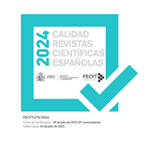Pragmagramática de "si es que": Más allá de la réplica y la justificación
Resumen
En este estudio presentamos una descripción pragmagramatical del elemento si es que. Se trata de una combinatoria de dos elementos, el conector si y el operador de intensificación es que, que aparecen con frecuencia en determinados contextos de uso. Mediante el análisis cualitativo de ejemplos reales, trataremos de enumerar cuáles son los valores que adquiere en estos contextos teniendo en cuenta su inclusión en la macroestructura del discurso: dimensión informativa, modal y argumentativa. Para ello, veremos cómo los componentes internos de los enunciados introducidos por si es que se relacionan con el resto de elementos del texto y con la situación comunicativa, de tal manera que podamos identificar las características que son propias de esta estructura y qué la diferencia de otros fenómenos lingüísticos.Descargas
Descarga artículo
Licencia
La revista Círculo de Lingüística Aplicada a la Comunicación, para fomentar el intercambio global del conocimiento, facilita el acceso sin restricciones a sus contenidos desde el momento de su publicación en la presente edición electrónica, y por eso es una revista de acceso abierto. Los originales publicados en esta revista son propiedad de la Universidad Complutense de Madrid y es obligatorio citar su procedencia en cualquier reproducción total o parcial. Todos los contenidos se distribuyen bajo una licencia de uso y distribución Creative Commons Reconocimiento 4.0 (CC BY 4.0). Esta circunstancia ha de hacerse constar expresamente de esta forma cuando sea necesario. Puede consultar la versión informativa y el texto legal de la licencia.











